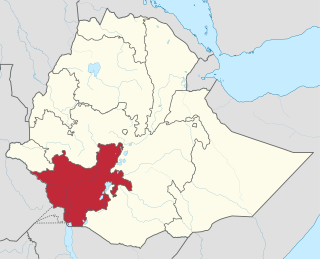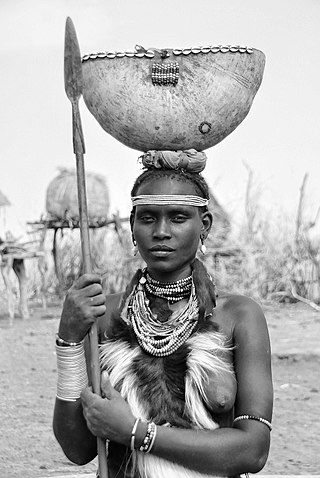
The Cushitic languages are a branch of the Afroasiatic language family. They are spoken primarily in the Horn of Africa, with minorities speaking Cushitic languages to the north in Egypt and Sudan, and to the south in Kenya and Tanzania. As of 2012, the Cushitic languages with over one million speakers were Oromo, Somali, Beja, Afar, Hadiyya, Kambaata, and Sidama.

The Omotic languages are a group of languages spoken in southwestern Ethiopia, in the Omo River region and southeastern Sudan in Blue Nile State. The Geʽez script is used to write some of the Omotic languages, the Latin script for some others. They are fairly agglutinative and have complex tonal systems. The languages have around 7.9 million speakers. The group is generally classified as belonging to the Afroasiatic language family, but this is disputed by some.
Amharic is an Ethiopian Semitic language, which is a subgrouping within the Semitic branch of the Afroasiatic languages. It is spoken as a first language by the Amharas, and also serves as a lingua franca for all other populations residing in major cities and towns in Ethiopia.
Ongota is a moribund language of southwest Ethiopia. UNESCO reported in 2012 that out of a total ethnic population of 115, only 12 elderly native speakers remained, the rest of their small village on the west bank of the Weito River having adopted the Tsamai language instead. The default word order is subject–object–verb. The classification of the language is obscure.

The Southern Nations, Nationalities, and Peoples' Region was a regional state in southwestern Ethiopia. It was formed from the merger of five kililoch, called Regions 7 to 11, following the regional council elections on 21 June 1992. Its government was based in Hawassa.

The Kingdom of Kaffa was a kingdom located in what is now Ethiopia from 1390 to 1897, with its first capital at Bonga. The Gojeb River formed its northern border, beyond which lay the Gibe kingdoms; to the east the territory of the Konta and Kullo peoples lay between Kaffa and the Omo River; to the south numerous subgroups of the Gimira people, and to the west lay the Majangir people. The native language, also known as Kaffa, is one of the Omotic group of languages.
Harari is an Ethiopian Semitic language spoken by the Harari people of Ethiopia. According to the 2007 Ethiopian census, it is spoken by 25,810 people. Harari is closely related to the Eastern Gurage languages, Zay, and Silt'e, all of whom are believed to be linked to the now extinct Semitic Harla language. Locals or natives of Harar refer to their language as Gē Sinan or Gē Ritma'language of the City'. According to Wolf Leslau, Sidamo is the substratum language of Harari and influenced the vocabulary greatly. He identified unique Cushitic loanwords found only in Harari and deduced that it may have Cushitic roots.

The languages of Ethiopia include the official languages of Ethiopia, its national and regional languages, and a large number of minority languages, as well as foreign languages.

The Daasanach are an ethnic group inhabiting parts of Ethiopia, Kenya, and South Sudan. Their main homeland is in the Debub Omo Zone of the Southern Nations, Nationalities, and People's Region, adjacent to Lake Turkana. According to the 2007 national census, they number 48,067 people, of whom 1,481 are urban dwellers.

South Omo Zone is a zone in the Ethiopian South Ethiopia Regional State. South Omo is bordered to the south by Kenya, to the southwest by the South Sudan, to the west by Bench Maji, to the northwest by Keffa, to the north by Konta, Gamo Gofa and Basketo, to the northeast by Dirashe and Konso and to the east by the Oromia Region. The administrative center of South Omo is Jinka.
Kuraz is one of the woredas in the Southern Nations, Nationalities, and Peoples' Region of Ethiopia. It is the homeland of Daasanach people. Part of the Debub Omo Zone, Kuraz is bordered on the south by Kenya, on the west by the Ilemi Triangle, on the north by Nyangatom, and on the east by Hamer. The Omo River is flowing through Kuraz to Lake Turkana at the border of Kenya. The administrative center of this woreda is Omorate. Nyangatom woreda was separated from Kuraz.
Arbore is an Afro-Asiatic language spoken by the Arbore people in southern Ethiopia in a few settlements of Hamer woreda near Lake Chew Bahir.
Baiso or Bayso is an Afro-Asiatic, more specifically a Lowland East Cushitic language belonging to the Omo-Tana subgroup, and is spoken in Ethiopia, in the region around Lake Abaya.
The (Western) Omo–Tana or Arboroid languages belong to the Afro-Asiatic family and are spoken in Ethiopia and Kenya.
The Somali languages form a group that are part of the Afro-Asiatic language family. They are spoken as a mother tongue by ethnic Somalis in Horn of Africa and the Somali diaspora. Even with linguistic differences, Somalis collectively view themselves as speaking dialects of a common language.
The Omo–Tana languages are a branch of the Cushitic family and are spoken in Ethiopia, Djibouti, Somalia and Kenya. The largest member is Somali. There is some debate as to whether the Omo–Tana languages form a single group, or whether they are individual branches of Lowland East Cushitic. Blench (2006) restricts the name to the Western Omo–Tana languages, and calls the others Macro-Somali.
Hozo is an Afroasiatic language spoken mostly in the Kondala woreda of Mirab Welega Zone by peoples generically known as "Mao". There are smaller groups of Hozo speakers in Mana Sibu woreda. The term Hozo is usually understood by the Mao to refer to a clan. Hozo speakers prefer to call themselves Amo. Hozo and Seze are sometimes called Begi Mao. Hozo is spoken by roughly 3,000 people in Ethiopia. Hozo is also a clan in the Begi area. The Hozo language is also known as Begi-Mao and Mao of Begi. Its classification is Afro-Asiatic, Omotic, and Mao. The word Mao is Omotic and means ‘man; people’, occurring as [ma:ɪ] in Seze and as [mɔ:] in Hozo. Mao is frequently used as an ethnic term. There is a kind of Mao identity across language differences in Ethiopia. While it is generally accepted today that Omotic is one of the primary branches of the Afro-Asiatic family, the position of the four languages Hozo, Seze, Ganza and Northern Mao is still being discussed. The Mao languages are the least documented within Omotic, and Omotic itself is the least documented of the Afroasiatic groups.
Nyangatom is a Nilotic language spoken in Ethiopia by the Nyangatom people. It is an oral language only, having no working orthography at present. Related languages include Toposa and Turkana, both of which have a level of mutual intelligibility; Blench (2012) counts it as a dialect of Turkana.

The Kwegu are an ethnic group that lives on the western banks of the Omo River in the newly formed South Ethiopia Region. Some members of the Kwegu also live on the eastern banks of the river among the Mursi. Previously they were hunter-gatherers, but today they are engaged in a mixed economy of hunting, farming, beekeeping, and fishing.

The El Molo, also known as Elmolo, Dehes, Fura-Pawa and Ldes, are an ethnic group mainly inhabiting the northern Eastern Province of Kenya. They historically spoke the El Molo language as a mother tongue, an Afro-Asiatic language of the Cushitic branch, and now most El Molo speak Samburu.










